Physikerin der Woche 2023
Since January 2018, the working group on equal opportunities (AKC) of the German Physical Society (DPG) has highlighted weekly women in physics in Germany or German women in physics abroad.
Are you a woman in physics in Germany or a German woman in physics abroad, and would you like to highlight your work within the "Physikerin der Woche" initiative? If so, don't hesitate to contact Dr. Ulrike Boehm at . Women in physics of all career stages from academia and industry can participate. Also, please feel free to suggest any suitable candidates.
You can find an article and posters about our initiative in the April 2018 issue and 2021 / 2022 / 2023 issues of the Physik-Journal. Please feel free to print the posters and advertise our initiative at your research institution. Participants of previous years can be found here: 2018, 2019, 2020, 2021, and 2022.
Weitere interessante Infomationen zum Thema Berufsvorbereitung für PhysikerInnen können auch auf den folgenden DPG Seiten gefunden werden: Berufsvorbereitendes Programm der DPG und DPG-Berufsvorbereitung online der jDPG
Dezember
Dr. Annemarie Lüdecke (München) - Kalenderwoche 52

After obtaining a diploma from FU Berlin with a thesis on measuring kinetics with surface-enhanced infrared spectroscopy, Annemarie went on to complete her Ph.D. at the Dresden International Graduate School for Biomedicine and Bioengineering. There, she studied the interplay of microtubules and several of their associated proteins with total internal reflection fluorescence imaging and optical tweezers to better understand their potential role in the formation of the mitotic spindle during cell division.
When leaving academia for a career in industry, Annemarie was intrigued by the opportunity to shift her focus from surface-based to in-solution methods. At NanoTemper Technologies, she has been inventing and improving fluorescence-based, biophysical methods to study proteins and their interactions, enabling researchers in academia and the pharmaceutical industry to gather more insightful data.
Photo/Credit: Dr. Annemarie Lüdecke
Dr. Alessia Platania (Waterloo, Ontario, Canada) - Kalenderwoche 51

Alessia is a researcher at the Perimeter Institute for Theoretical Physics in Canada. Her research lies at the interface between quantum gravity, astrophysics, and cosmology.
She identified the cross-fertilization of methods and approaches as a key ingredient to make progress in quantum gravity and bridge the gap between theory and observations.
Alessia's research focuses on contrasting the "quantum gravity landscapes" stemming from different theories and investigating how quantum gravity impacts the internal structure of black holes and the primordial evolution of the universe. Alessia pioneered some of these novel research avenues during her first postdoc at the Institute for Theoretical Physics of Heidelberg University, where she held a Humboldt Research Fellowship for two years.
Alessia is also very active in mentoring students, fostering an inclusive research environment, and organizing seminars and conferences. Learn more on the HAInet magazine (pages 14-15) and Perimeter Institute's article.
Photo/Credit: Dr. Alessia Platania
M.Sc. Katarina Chapman (Heidelberg) - Kalenderwoche 50

Katarina studied physics at Heidelberg University and is interested in applying physics methods to answer biological questions. In her Bachelor's thesis, she worked on super-resolution microscopy and developed a new dual-color imaging method that was used to investigate the interaction of DNA with proteins in cancer cell nuclei. She continued her Master's studies in Heidelberg in the group of Prof. Stefan Hell at the Max Planck Institute for Medical Research. There, she explored the theoretical and experimental limits of MINFLUX nanoscopy, a new concept for localizing emitting molecules with nanometer precision using the lowest possible number of fluorescence photons. Katarina started her Ph.D. in the same group recently and is excited to continue her research on MINFLUX nanoscopy.
The photo shows Katarina with her images of fluorescently labeled DNA in cell nuclei.
Photo/Credit: M.Sc. Katarina Chapman
Prof. Dr. Anna Nelles (Erlangen/Zeuthen) - Kalenderwoche 49

Anna is a professor of astroparticle physics at the University of Erlangen-Nürnberg and a group leader at the Helmholtz Research Center DESY, located in Zeuthen, near Berlin.
She works on the radio detection of neutrinos and cosmic rays. They are currently constructing the most sensitive neutrino array to date on the top of the Greenlandic Ice Sheet, the Radio Neutrino Observatory, RNO-G. It sets out to discover neutrinos above PeV energies. For this project, she has been awarded an ERC Starting Grant.
Anna also uses the world's largest radio telescope, LOFAR, to detect air showers stemming from cosmic rays to study their origin and nature.
Photo/Credit: DESY/ Axel Hagedorn
November
Prof. Dr Anna Franckowiak (Bochum) - Kalenderwoche 48

Photo/Credit: Prof. Dr Anna Franckowiak
Dr. Nora Martin (Barcelona) - Kalenderwoche 47

Photo/Credit: Dr. Nora Martin
M.Sc. Anne Forstinger (Cologne) - Kalenderwoche 46

Anne is working as a project engineer at CSP Services and is responsible for the operation, data quality control, and data dissemination of automatic weather stations running worldwide. Clients use the information provided by Anne to characterize the solar irradiance on a planned solar power plant site. The data acquired is considered bankable and helps the client to ensure the most favorable financing conditions. Due to her know-how, Anne leads the activity within the International Energy Agency Photovoltaic Power Systems Program to benchmark different satellite and weather model radiation data against over 120 ground stations worldwide. Her main focus overall is to reduce the uncertainty in the solar resource and other environmental factors for a solar power plant project.
Photo/Credit: M.Sc. Anne Forstinger
M.Sc. Barbara Paetsch (Rehovot, Israel) - Kalenderwoche 45

Barbara is a Ph.D. student in experimental astroparticle physics at the Weizmann Institute of Science in Israel. Her group is part of the XENON collaboration, a collaboration from over 25 institutions across the world searching for dark matter since 2006 with liquid xenon time projection chambers in a series of experiments.
With the latest experiment upgrade XENONnT at the Laboratori Nazionali del Gran Sasso (LNGS) in Italy, they are looking for new physics beyond the standard model, with the primary goal of the direct dark matter detection of weakly interacting massive particles (WIMPs), which are one of the dark matter candidates in our Universe.
But they are also sensitive to other events, such as studying rare weak decay channels like the double electron capture in Xe-124 or the (neutrinoless) double beta decay in Xe-136. Additionally, they are exploring neutrino properties through endeavors like precision measurements of the solar pp neutrino flux, assessments of the solar metallicity via boron-8 neutrinos, and direct measurements of solar CNO neutrinos.
In addition to her work for the XENONnT experiment, Barbara studies liquid xenon scintillation light's temporal and spatial structures with a radiation detection experiment called DireXeno (directional xenon) located at the nuclear research facility, Soreq, in Israel.
The picture was taken in her lab at Weizmann while showing cosmic rays with a small particle detection setup as part of an outreach program.
Update from November 4: Barbara left Israel temporarily due to the war, leaving most of her things behind. She stays with her family in Germany and works as far as possible remotely - Mainly doing data analysis. A significant part of the research in Weizmann, especially lab work, is not happening at the moment, not only because of the frequent rockets but also because approximately a third of students and researchers are currently serving in military operations. Barbara hopes for a soon return to Israel and her research on-site.
Photo/Credit: M.Sc. Barbara Paetsch
Oktober
Dr. Saša Bajt (Hamburg) - Kalenderwoche 44

Saša heads a group in the Center for Free-Electron Science (CFEL) at DESY (Hamburg) and is also a principal investigator in the Cluster of Excellence (CUI) at the University of Hamburg. She invented new multilayer structures (utilizing interface engineering) that lead to word-record reflectivity Extreme Ultraviolet (EUV) multilayers for EUV Lithography. She is one of the pioneers in XFEL science. Her optics enabled the first coherent diffraction imaging experiments and the first warm dense matter experiment with soft X-ray FEL beam. Saša is currently developing a new generation of X-ray lenses and X-ray microscopes, which will enable multidimensional studies of different materials and biological samples on a nanometer scale. In combination with novel coherent X-ray sources, her multilayer-based X-ray lenses and optical components open up new applications for investigating quantum materials and the architecture of biological cells. Slovenian-born Saša was also honored as an Ambassador of Science, one of the highest national prizes of the Republic of Slovenia, and is an Optica Fellow.
The photo shows Saša at a synchrotron beamline during one of her experiments.
Photo/Credit: Dr. Saša Bajt
M.Sc. Jowita Borowska (Berlin) - Kalenderwoche 43

Jowita is a Ph.D. student at the Humboldt University of Berlin. She is a researcher in astroparticle physics, and her work links optical astronomy and gamma-ray astronomy together. She uses information from wide-field-of-view optical telescopes to identify promising sources for gamma-ray follow-ups with the High Energy Stereoscopic System (H.E.S.S.), and she analyzes data obtained through such observations. Her research provides important insights into the search for some of the highest-energy sources in the Universe and focuses primarily on interacting supernovae (massive stars that explode at the end of their lives and interact with the surrounding material, creating excellent conditions for the effective acceleration of particles).
The picture shows her with the telescopes.
Photo/Credit: M.Sc. Jowita Borowska
M.Sc. Lena Tarrach (Wuppertal) - Kalenderwoche 42

Lena is a doctoral researcher in the group for theoretical chemical physics at the University of Wuppertal. Her field of research focuses on polymer science, which is situated at the interface between chemistry, physics, and engineering. She currently develops a model that enables the simulation of filled strain-crystallizing elastomer networks on a mesoscopic scale. The aim of her work is to investigate the differences and the interplay of reinforcement by filler and strain-induced crystallization. This model features properties of natural rubber, which is widely used in industrial applications such as tires and, therefore, of high research interest. During her Master's studies, she already specialized in this area and received the prize of VDI Bergischer Bezirksverein for her thesis ''Modelling Study of Reinforcement and Crack Formation in Strain-Crystallizing Elastomer Networks''.
Photo/Credit: M.Sc. Lena Tarrach
Dr. Nora Linn Strotjohann (Rehovot, Israel) - Kalenderwoche 41
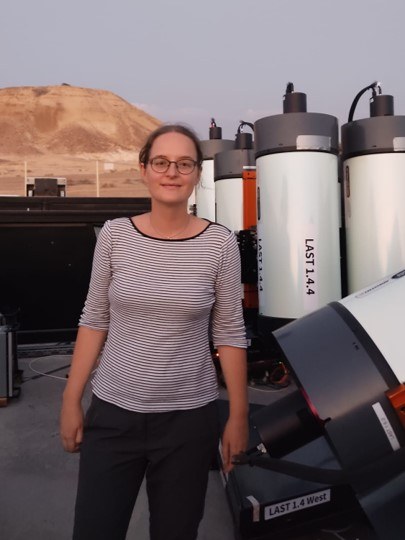
Nora is a Walter Benjamin fellow in the astrophysics group at the Weizmann Institute of Science, where she works as the project scientist of the Large Array Survey Telescope (LAST). LAST is a novel type of telescope that is currently under construction in the Negev desert in the south of Israel. It will consist of 48 off-the-shelf telescopes (32 deployed so far) that monitor the sky to discover transient or variable sources. The combined mirror surface is equivalent to a 1.9m-diameter telescope at a fraction of the cost and with more flexibility due to the modular design.
Besides the hands-on fieldwork, her main research interests are massive stars in the last years before they explode as supernovae. Apparently, nuclear-burning processes in the center of the star sometimes trigger violent outbursts that announce the supernova. She searches for these eruptions and characterizes them with the goal of understanding which processes ultimately lead to the supernova explosion.
Update from October 13: Due to the war with Hamas, Nora has left Israel temporarily. During the last week, the Weizmann Institute and large parts of Israel suffered from regular missile attacks, and most scientists shelter at home. Their observatory appears to be undamaged so far, and they hope to return soon.
Photo/Credit: Dr. Nora Linn Strotjohann
Prof. Dr. Anne L'Huillier (Lund, Sweden) - Kalenderwoche 40
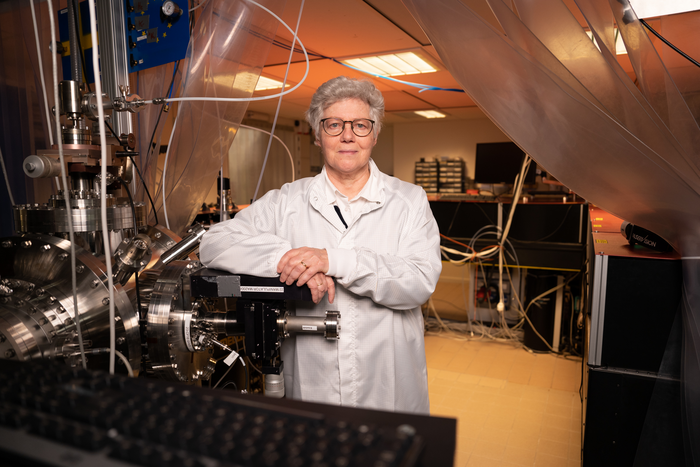
In 2023, she became the fifth woman to be awarded the Nobel Prize in Physics. The prize was awarded jointly to Pierre Agostini, Ferenc Krausz, and Anne L’Huillier "for experimental methods that generate attosecond pulses of light for the study of electron dynamics in matter."
Photo/Credit: BBVA Foundation
September
Prof. Dr. Antonia Statt (Urbana Illinois) - Kalenderwoche 39

Antonia is an Assistant Professor in the Materials Science and Engineering department at the University of Illinois Urban Champaign. Before moving to the US for her academic career, starting with a postdoctoral fellowship at Princeton University, she completed her Ph.D. in Physics at the University of Mainz, Germany. Her research is motivated by the complexity of soft matter motivated by challenges in energy, environment, and technology. She is particularly interested in the crystallization and aggregation of polymers and colloidal systems and non-equilibrium effects like flow or evaporation. Aggregation of colloidal particles is a big area of focus in her group since it is important for many different systems, from paints to microplastics in our environment. Her work integrates empirical model development, statistical mechanics, applications of machine learning techniques, and highly efficient GPU-accelerated simulations.
Photo/Credit: Prof. Dr. Antonia Statt
M.Sc. Lea Kämmerer (Duisburg-Essen) - Kalenderwoche 38

Lea is a Ph.D. student in the group of Heiko Wende at the University of Duisburg-Essen. As a member of the SFB1242, she studies ultrafast non-equilibrium dynamics in condensed matter, with a focus on the investigation of ultrafast dynamics in spin-crossover molecules using time-resolved X-ray absorption spectroscopy.
Spin-crossover molecules have two distinct spin states, a low-spin and a high-spin state, which can be switched between by external stimuli such as light or temperature. Pump-probe experiments such as time-resolved X-ray absorption spectroscopy cannot be performed in a university lab, so she goes to the European XFEL, where extremely intense X-ray pulses are generated, which she needs to get the energy and time resolution to resolve the dynamics in spin-crossover molecules.
The picture was taken in the clean room of the European XFEL, where she successfully mounted the samples for the beamtime.
Photo/Credit: Tobias Lojewski, AG Wende
M.Sc. Jelena Köhler (Karlsruhe) - Kalenderwoche 37
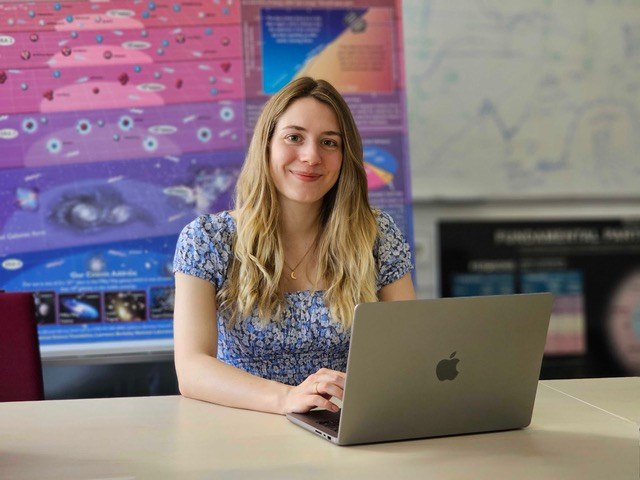
Jelena is a doctoral researcher at the Institute for Astroparticle Physics (IAP) of KIT. Since her master's thesis at BUW, her research has been dedicated to understanding the highest energy processes in our Universe. To do this, she measures high-energy cosmic particles via their radio emission in the atmosphere.
She is part of the NUTRIG group, which aims to develop an efficient and scalable trigger system for the detection of cosmic rays and neutrinos using large-scale radio antenna arrays. Jelena’s work on the autonomous trigger mainly contributes to the GRAND project, a huge radio-antenna array for the detection of high-energy neutrinos in the development stage, but has general relevance for the radio detection technique.
In addition to her research, Jelena serves as a Ph.D. representative for her graduate school, KSETA, advocating the interests of her peers. Through the DAAD RISE program, she currently mentors a student from Penn State University, US, focusing on software development and air-shower reconstruction.
Photo/Credit: M.Sc. Jelena Köhler
Dr. Johanna Hartke (Turku, Finland) - Kalenderwoche 36
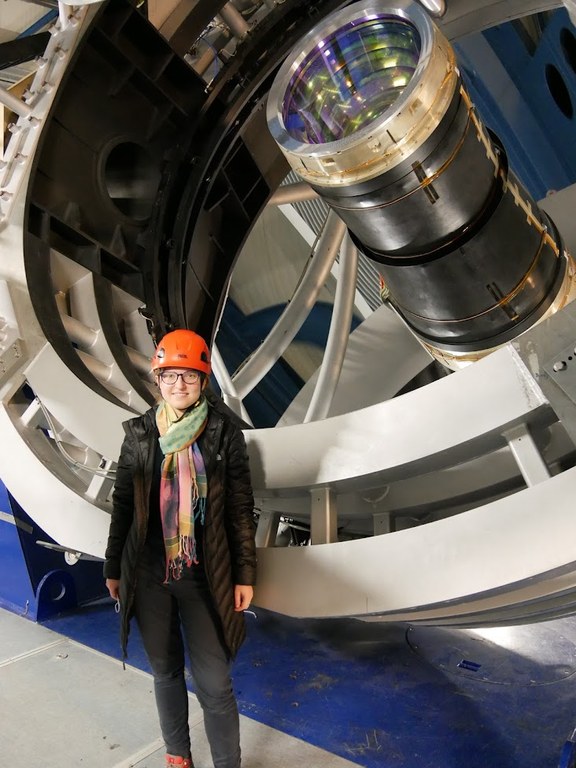
Photo/Credit: Dr. Johanna Hartke
August
M.Sc. Verena Feulner (Erlangen) - Kalenderwoche 35

Photo/Credit: FAU/Boris Mijat
M.Sc. Katrin Bolsmann (Aachen/Jülich) - Kalenderwoche 34

Photo/Credit: M.Sc. Katrin Bolsmann
Dr. Antonia Schmalz (Leipzig) - Kalenderwoche 33

Antonia is a project manager at SPRIND GmbH (Federal Agency for Disruptive Innovation), where she is responsible for physics-related topics and projects in the field of microelectronics and computing. With a passion for new, emerging, exciting technologies, she supports innovators on their path to market success. Having completed her Ph.D. in laser-driven particle acceleration at the Max-Planck-Institute für Quantum Optics, Antonia is now coming back closer to those roots as she is leading the newly founded SPRIND-subsidiary Pulsed Light Technologies GmbH. The company focuses on developing high-intensity lasers for laser-driven inertial fusion. Working closely with fusion start-ups Focused Energy and Marvel Fusion, their shared goal is to pave the way toward a fusion power plant. Between those stages, she advised ministries at the state and federal levels on research funding for projects in microelectronics with a focus on chip design and semiconductor technologies.
Photo/Credit: Dr. Antonia Schmalz
Jun. Prof. Dr. Jana Günther (Wuppertal) - Kalenderwoche 32

Jana is an assistant professor (Juniorprofessorin) at the Bergische Universität Wuppertal. Her research focuses on studying the QCD phase diagram using lattice gauge theory methods. In particular, she is concerned with the behavior of QCD matter at finite densities, which is a particular challenge for lattice QCD calculations. Here, the notorious "sign problem" prevents the use of the established Monte Carlo simulations, which is why new methods are sought, or extrapolations are used to solve QCD in this domain. The knowledge gained in this way can be used to understand heavy ion collisions at particle accelerators and theoretically explain the results obtained there from first principles. To reproduce the experimental conditions in lattice QCD simulations, she uses the method of analytical continuation from imaginary chemical potential.
Learn more about Jana in an interview conducted by her university.
Photo/Credit: Prof. Dr. Jana Günther
Juli
Dr. Kathrin Aziz-Lange (Oberkochen) - Kalenderwoche 31
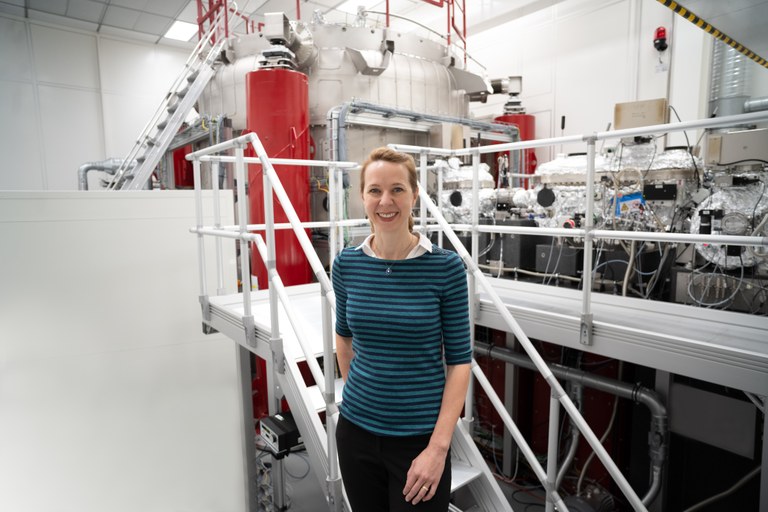
Kathrin is Head of Coating and Surface Roughness Metrology at ZEISS Semiconductor Manufacturing Technology in Oberkochen, Germany. The department of around 80 scientists and engineers focuses on the development of metrology processes that enable high-precision measurements of optical components for the extreme ultraviolet (EUV) lithography optics manufactured by ZEISS. These optical systems are later integrated into microchip manufacturing machines. The accuracy specifications of these systems range into sub-nanometer dimensions and are often beyond everything that can be found on the market. Therefore, they also pose great challenges for the development of the metrology machines and processes for their components concerning precision, size, and reliability. The spectrum of methods in Kathrin’s responsibility covers, amongst others, atomic force microscopy, interferometry, defect detection, and EUV-reflectometry and allows, e.g., to prove surface roughness down to sub-nanometers.
Before joining ZEISS, Kathrin held a Junior professorship at Bielefeld University and was a Helmholtz Young Investigator group leader, focusing on solar fuel research.
Photo/Credit: Carl Zeiss AG/Manfred Stich
Dr. Meike Küßner (Bochum) - Kalenderwoche 30

Photo/Credit: Dr. Meike Küßner
Dr. Anna Chrobry (Bremen) - Kalenderwoche 29

Photo/Credit: Dr. Anna Chrobry
Dr. Anjana Ashok (Hannover) - Kalenderwoche 28

Photo/Credit: Dr. Anjana Ashok
Dr. Chiara Lindner (Freiburg) - Kalenderwoche 27

Chiara is a scientist researching novel techniques for spectroscopy at the Fraunhofer Institute for Physical Measurement Techniques in Freiburg.
Her research focuses on using entangled photon pairs for sensitive high-resolution mid-infrared spectroscopy. The idea is to use a correlated pair of one mid-infrared (for sample interaction) and one near-infrared photon (for highly sensitive detection) and transfer the information between them using quantum interference effects. As Chiara and her colleagues found out, the quantum interferometer can be operated in close analogy to a classical Fourier-transform spectrometer, which greatly improves the spectral resolution and measurement accuracy.
For her Ph.D. studies, Chiara has received the Quantum Futur Award (1st place), awarded by the BMBF, and the Hugo-Geiger Preis (2nd place) awarded by the Freistaat Bayern and the Fraunhofer Gesellschaft.
Foto-Rechte: Dr. Chiara Lindner
Juni
M.Sc. Anna Ravensburg (Uppsala, Sweden) - Kalenderwoche 26

Anna is currently writing her Ph.D. thesis on improving the crystal quality in single crystalline magnetic thin films, a work she conducted in the group of Prof. Vassilios Kapaklis at Uppsala University in Sweden. Limiting the amount of grain boundaries and crystallographic defects in such films enables the growth of high-quality artificial multilayered materials. Her main focus is to understand epitaxial metal/oxide interface structures to tune magnetic properties like interlayer exchange coupling in superlattices or THz emission in other spintronic devices for various technological applications.
Foto-Rechte: M.Sc. Anna Ravensburg
Prof. Dr. Dragana Ilic (Hamburg, Belgrade) - Kalenderwoche 25

Dragana is a Humboldt Fellow at the University of Hamburg and an Associate Professor at the University of Belgrade, Serbia. She has been engaged for many years in the optical spectroscopy of active galactic nuclei (AGN), focusing on resolving the inner regions through optical time-domain studies and reverberation mapping (RM). She has been fascinated with complex emission line features seen in optical AGN spectra, trying to understand their origin. For these studies, she contributed to the development of the open-source software for AGN spectral analysis - FANTASY. Lately, she has been intensely involved in preparation for the exploitation of the AGN time series from the Vera Rubin "Legacy Survey in Space and Time" (LSST) project. She is the Program Manager of the SER-SAG international in-kind team, which aims to employ photo-RM on AGNs and to compile a catalog of possible candidates for close-binary AGNs from the LSST survey. She advocates for diversity, equity, and inclusion in science on every level.
Foto-Rechte: Prof. Dr. Dragana Ilic
Dr. Micol Alemani (Potsdam) - Kalenderwoche 24
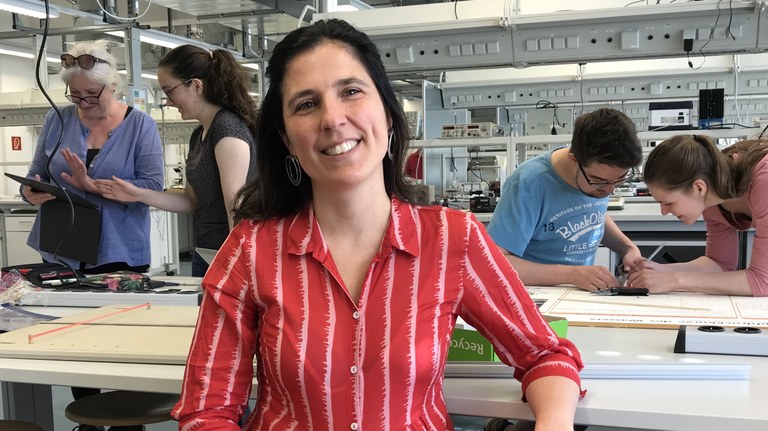
Micol is passionate about physics education research. She coordinates and teaches introductory physics laboratory courses at the University of Potsdam and, in recent years, has redesigned them to engage students collaboratively and creatively in authentic experimental activities.
She is doing research on students' learning in these contexts and works on developing effective teaching methods to develop students' experimental skills.
Before working in physical education research, she did physics research in molecular electronics and nanomaterials in Germany and the United States.
Pictured is Micol with four students working on an experimental project.
Foto-Rechte: Dr. Micol Alemani
M.Sc. Carina Kanitz (Ulm) - Kalenderwoche 23

Carina is an experimental physicist at the German Aerospace Center (DLR), Institute for Quantum Technologies, in Ulm, studying the quantum mechanical interaction of single atoms with two-dimensional materials like graphene. The diffraction of atoms at the grating structure of two-dimensional materials holds the potential to allow damage-free imaging and characterization of membranes. Additionally, atom diffraction at gratings could be the foundation for new sensors with unachieved precision due to the quantum nature of the effects at play.
Carina studied physics at FAU Erlangen-Nürnberg and did her master’s thesis in experimental nuclear physics at CERN. Currently, she is pursuing a Ph.D. at DLR and the University of Ulm.
Foto-Rechte: M.Sc. Carina Kanitz
Mai
Dr. Ulrike Kraft (Mainz) - Kalenderwoche 22

Ulrike is a Lise-Meitner-Research-Group leader for Organic Bioelectronics at the Max Planck Institute for Polymer Research in Mainz and works at the intersection between Physics, Chemistry, and Materials Science.
Ulrike and her group are interested in organic electronic materials such as semiconducting and conducting polymers and small molecules, the charge transport through these materials, and their application in flexible and stretchable electronic devices such as organic field-effect transistors and biosensors. Due to their printability, mechanical flexibility, and low Young's modulus that is in compliance with biological tissues, organic electronic materials and devices offer the potential to revolutionize personalized medicine and health monitoring applications.
Furthermore, it is Ulrike’s aim to characterize and develop environmentally friendly and biodegradable electronics for sustainable applications.
Foto-Rechte: Dr. Ulrike Kraft
April
Dipl.-Phys. Leli Schiestl (Berlin) - Kalenderwoche 17

Leli works remotely as a Data Engineer at Mozilla. Data engineers' job is to make data usable for data analysts. That includes finding relevant data, bringing the raw data in a useful format, and then automating that process for constantly updating data. Each new dataset is a new puzzle to solve, understanding how it has been generated, what questions can be answered with it - and equally or more important, what questions can not be answered with the current data.
In her free time, Leli is a member of "feminismus und computer kram," an online hackspace for women, non-binary and trans folks, and loves to put LEDs on everything.
Foto-Rechte: Dipl.-Phy. Leli Schiestl
März
Prof. Dr. Marina Gerhard (Marburg) - Kalenderwoche 13

Marina has held a tenure track position (W1) at the physics faculty at the Philipps-University Marburg since 2021. Her research interests focus on the optical properties of organic and hybrid semiconductors. Molecular materials are very versatile building blocks for organic electronic devices, and the flexibility of this material class can be even further enhanced in heterostructures. To understand the processes emerging after the absorption of light, e.g., photocurrent generation in an organic solar cell, it is important to comprehend the photoexcitation dynamics in time-resolved experiments. Marina’s junior research group is specialized in time-resolved photoluminescence spectroscopy combined with spatially resolved experiments. With this framework of techniques, it is possible to gain insight into the fate of bound electron-hole pairs. These so-called excitons are the primary photoexcited species in organic semiconductors. A part of the group’s research is embedded in the CRC 1083 “Structure and Dynamics at internal interfaces”.
Foto-Rechte: Prof. Dr. Marina Gerhard
M.Sc. Celina Hellmich (Braunschweig) - Kalenderwoche 11

Celina is a Ph.D. student at the TU Braunschweig and is currently a member of the working groups Nanostructuring and Microsystems Technology at PTB. There she contributes to the further development of high-precision measurement methods of 3D microscopes.
To measure accurately and with high precision with a microscope, it must first be calibrated with so-called standards. But in 3D microscopy, it is not only necessary to calibrate the lateral and height scales but also the calibration of the flatness error of coordinate planes and the shear of coordinate axes. 3D standards meet these requirements. However, currently used 3D standards are manufactured with focused ion beams. Each standard is, therefore, a cost-intensive custom-made product that also requires time-consuming calibration. Celina and her colleagues are developing a wafer-based mask process to produce 3D standards. This way, many structures can be reproducibly produced and adapted to calibrate the respective device.
Foto-Rechte: M.Sc. Celina Hellmich
Februar
Dr. Elena Redaelli (Garchign/Munich) - Kalenderwoche 8

Foto-Rechte: Dr. Elena Redaelli
Dr. Franziska Glassmeier (Delft) - Kalenderwoche 7

Franziska is an Assistant Professor at TU Delft and a Branco Weiss Fellow. Her research is broadly motivated by the complexity of clouds and approaches to capture this complexity – with the goal of better constraining the role of clouds in climate projections. Franziska is especially interested in the intriguing effects of cloud ice, the diverse interactions of clouds with atmospheric aerosol, and the marvelous patterns that cloud fields exhibit. Such patterns are strikingly visible in satellite images like the one behind her. Together with her group, she explores these phenomena by combining traditional process-based approaches and data science with concepts from complex systems theory. Before obtaining her Ph.D. in Atmospheric Physics from ETH Zurich, Franziska studied Physics at the University of Göttingen and completed her diploma thesis at the Max Planck Institute for Dynamics and Self-Organization.
Foto-Rechte: P. Alinaghi
Januar
Dr. Munan Gong (Garching/Munich) - Kalenderwoche 4

Munan is a postdoctoral researcher at the Center for Astrochemical Studies at the Max Planck Institute for Extraterrestrial Physics in Garching, Germany. She is interested in learning where we come from - how stars and planets form in the universe. She uses supercomputers to simulate the movement of gas and dust in galaxies, which eventually collapse under gravity to form stars and planets similar to our solar system. Her research helps to answer the questions such as how efficiently stars can form in galaxies and what environments are suitable for planet formation. Munan is also passionate about bringing astronomy to the public. Recently she worked with Soapbox Science Munich to discuss the mystery of the Christmas Star (and what astronomers think about the appearance of stars in the sky) in this video.
Foto-Rechte: Dr. Munan Gong
Dr. Birgit Stiller (Erlangen) - Kalenderwoche 3

Birgit is the leader of an independent Max Planck Research Group at the Max Planck Institute for the Science of Light in Erlangen. Her scientific focus is on experimental research in quantum optics and nonlinear photonics. At the heart of her research group is the interaction of light waves with sound waves – an effect that can enable versatile processing of optical information and manipulation of quantum states of light. The applications of her research lay within the areas of quantum technologies, such as secure quantum communication and novel optical computing approaches. Before Erlangen, she spent several years at the University of Sydney in Australia and earned her Ph.D. from the CNRS FEMTO-ST Institute in France.
A public talk on her science in German can be found here.
Foto-Rechte: SAOT, Max Gmelch
Dr. Larysa Baraban (Dresden) - Kalenderwoche 2

Foto-Rechte: Andre Wirsig, HZDR
M.Sc. Christina Möller (Göttingen) - Kalenderwoche 1

Foto-Rechte: M.Sc. Christina Möller
Hier geht es zu den Teilnehmerinnen der Physikerin der Woche 2018, 2019, 2020, 2021, und 2022 Projekte.